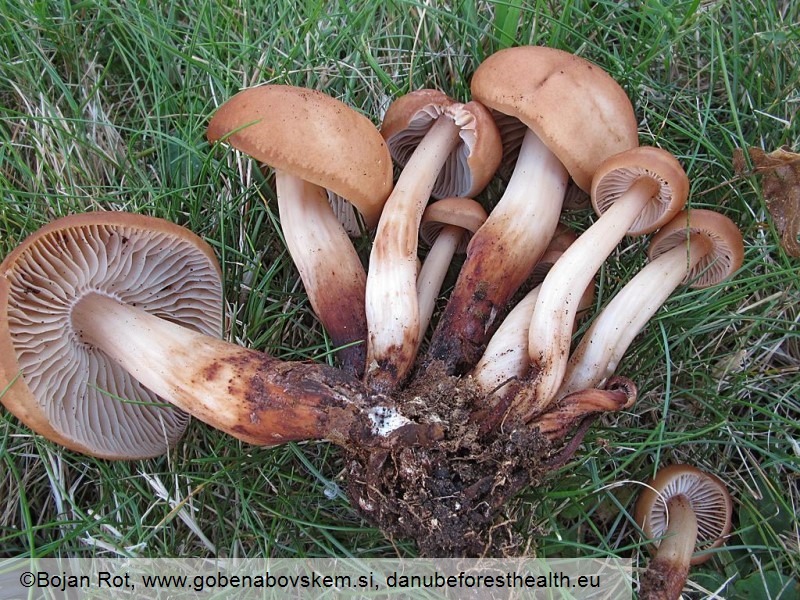Fungi
Spindle Shank
Gymnopus fusipes
Nikica Ogris, Thomas Cech
|
|

Fig. 1. Fruiting bodies of Gymnopus fusipes
DETECTION PERIOD:
Vegetation period, mostly June to October.
DESCRIPTION:
Gymnopus fusipes (formerly Collybia fusipes) is a parasitic species of gilled mushrooms which is quite common in Europe and the fruiting bodies often grow in large fascicles. Despite a high variability it is easy to recognize on close examination, at least when not young, due to the distinctive tough stipe: (1) The cap is circular, ripened flat, dark red-brown, later pale reddish with dark spots, smooth to wrinkled and up to 80 mm wide; (2) There is no ring or other veil remnant. The stipe is often flattened and usually lightly inflated in the central part, ca. 5–20 mm wide, dark red brown to flesh-coloured with a lighter tip. Its surface is characteristically furrowed and extended at the base into a root-like spindle, in total up 10–200 mm in length; (4) The distinctive spindle-shaped stipe-part of this mushroom is often buried in the soil thus visible only after excavation.; (5) The usually well-spaced gills are whitish-grey to flesh coloured, often with spots, and attached to the stipe in form of a ring.
HABITAT:
This mushroom grows in often large fascicles at the base of trees, or on roots or stumps. It is always associated with wood, which may however be buried and not immediately visible. Its main host is oak, but sometimes it is also found on beech. This mushroom is saprobic on dead wood and it is also a serious parasite.
STATUS:
It is found throughout Europe, where it is particularly common in warm dry central and southern countries, and in many parts of Asia. In the USA and Canada this fungus is considered an invasive species and a serious pest. It is parasitic, usually entering trees through roots. It favours light, sandy soils.
IMPACT:
It is a serious parasite of oak trees, causing a root rot and oak decline.
SIMILAR SPECIES:
The distinctive shape of the stem makes it almost impossible to confuse this species with any of the other common woodland mushrooms. Sometimes we can mistake it for Flammulina velutipes, which grows during winter (Gymnopus fusipes grows during summer/autumn) on stumps of different broadleaves and has a yellowish, slimy cap and a velvety brown basal stipe part.
|